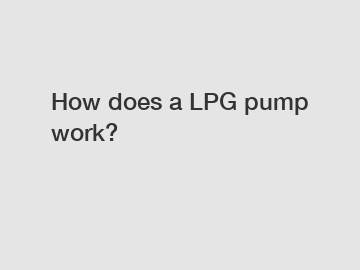How does a LPG pump work?
How Does an LPG Pump Work?
Liquefied Petroleum Gas (LPG) is a clean and efficient alternative fuel source commonly used for various applications such as cooking, heating, and transportation. To access this valuable resource, LPG pumps play a vital role in facilitating its storage and distribution. In this article, we will explore the inner workings of an LPG pump, providing insights into its functioning and key components.
LPG pumps are specially designed machines that allow for the safe and efficient transfer of liquefied petroleum gas from storage tanks to various outlets. These pumps are commonly found at gas stations and industrial sites and are crucial for providing a steady supply of LPG. Understanding the working principles of an LPG pump can significantly enhance our knowledge of how this valuable resource is distributed.

Pressure Regulator and Relief Valve.
At the heart of an LPG pump lies the pressure regulator, a key component responsible for maintaining the optimal pressure during the transfer process. The pressure regulator ensures that the LPG flowing out of the pump is at the desired pressure level, enabling safe and efficient usage. Additionally, a relief valve is incorporated into the system as a safety mechanism. If the pressure exceeds the set limits, the relief valve opens, allowing the excess gas to escape, thus preventing any potential accidents.
Positive Displacement Pump.
The positive displacement pump is a critical component in LPG pumps. As the name suggests, it works by displacing a definite amount of LPG with each revolution. This pump operates by trapping a specific volume of gas in a chamber, and as it rotates, it reduces the volume of that chamber, thus forcing the LPG to flow. This continuous process ensures a steady and reliable supply of fuel.
Flow Meter.
To accurately measure the quantity of LPG being dispensed, a flow meter is installed in the pump system. The flow meter records the volume of LPG passing through it, providing essential data for billing and inventory purposes. This allows businesses to maintain accurate records of their fuel usage and avoid any discrepancies.
Control Panel.
Modern LPG pumps often feature a control panel that allows operators to monitor and control different aspects of the pump's functionality. The control panel typically displays important information such as pressure levels, flow rate, and any potential alarms or warnings. Through the control panel, operators can adjust settings, troubleshoot issues, and ensure the seamless operation of the pump.
Safety Measures.
Safety is paramount when it comes to handling LPG, and LPG pumps are equipped with various safety features to minimize the risk of accidents. Some common safety measures include emergency shutdown valves, leak detection systems, and automatic fire suppression systems. These precautionary measures ensure that any potential hazards are detected swiftly, and appropriate actions are taken to prevent any damage or harm.
Conclusion.
LPG pumps are essential components in the storage and distribution of this clean and versatile fuel source. Understanding how these pumps work provides us with insights into the precise mechanisms that allow for the safe and efficient transfer of LPG from storage tanks to various outlets. By incorporating key components such as pressure regulators, positive displacement pumps, flow meters, and safety features, LPG pumps ensure a continuous and reliable supply of LPG for our daily needs.
If you have any further questions about LPG pumps or would like to know more about their functioning, please do not hesitate to contact us.
Want more information on hydrostatic test pressure chart, small nitrogen pump, brake hose testing? Feel free to contact us.


